mobile View, to the German Version tap the flag


- Kingdom of Denmark
- parliamentary monarchy
- own name: Kongerget Danmark
• Flags
• Historical Flags
• Meaning/Origin of the Flag
• regional Flags:
– Æro Island
– Bornholm Island
• Coat of Arms
• Meaning/Origin of the Coat of Arms
• Possessions:
– Greenland
– Faroe Islands
• Aircraft Roundel
• Map
• Numbers and Facts
• History
• Origin of the Country's Name
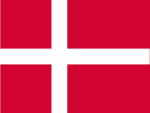
National and merchant flag,
ratio = 28:37,
Source, by: Corel Draw 4





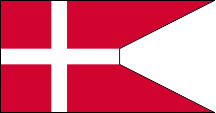
Ashore state flag,
ratio = 28:53,5,
Source, by: Flags of the World



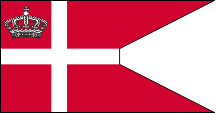
Offshore state flag,
ratio = 28:53,5,
Source, by: Flags of the World



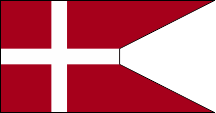
Naval flag and naval jack,
ratio = 28:53,5,
Source, by: Flags of the World



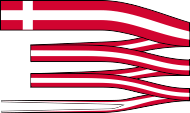
Masthead pennant,
Source, by: Flags of the World
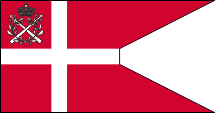
Customs flag,
ratio = 28:53,5,
Source, by: Flags of the World



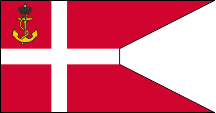
1. Official flag of the Navy,
Source, by: Die Welt im bunten Flaggenbild
2. Flag for aux ships,
Source, by: Flags of the World
ratio = 28:53,5



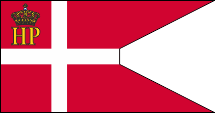
Official flag of the Harbour's Police,
ratio = 28:53,5,
Source, by: Die Welt im bunten Flaggenbild



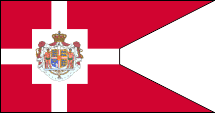
Royal flag,
ratio = 28:53,5,
Source, by: Flaggen und Wappen



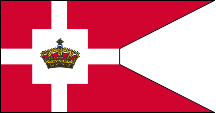
Flag of members of the Royal House,
ratio = 28:53,5,
Source, by: Die Welt im bunten Flaggenbild



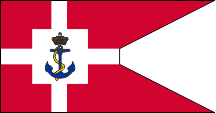
Flag of the Minister of Defense,
ratio = 28:53,5,
Source, by: Die Welt im bunten Flaggenbild



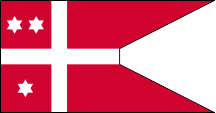
Flag of Admirals,
ratio = 28:53,5,
Source, by: Die Welt im bunten Flaggenbild



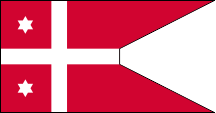
Flag of Vice Admirals,
ratio = 28:53,5,
Source, by: Die Welt im bunten Flaggenbild



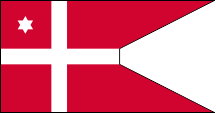
Flag of Rear Admirals,
ratio = 28:53,5,
Source, by: Die Welt im bunten Flaggenbild



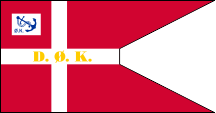
since 1897,
Flag of the Danish East Asia Company,
ratio = 28:53,5,
Source, by: Die Welt im bunten Flaggenbild



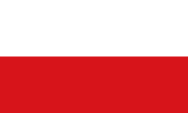
Pilot's flag,
ratio = 2:3,
Source, by: Die Welt im bunten Flaggenbild,
FOTW,
Foto



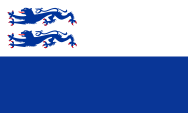
Flag of the Association of the German North Schleswiger,
ratio = 2:3,
Source, by: Wikipedia (DE)




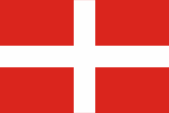
13th to 19th century,
Initial form with symmetric cross,



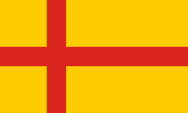
1396–1523,
Flag of the Kalmar Union (Denmark, Norway, Sweden),
Source, by: Alex Heick



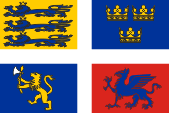
1396–1523,
Ship flag of the Kalmar Union (Denmark, Norway, Sweden),
Source, by: Knut Andersen (NO)



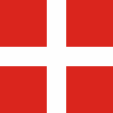
16th to 19th century,
Square variant,



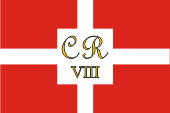
1839–1848,
Merchant flag for the Mediterranean Sea,
Source, by: Flaggen aller Seefahrenden Nationen



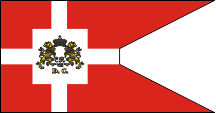
1616–1840(?),
Flag of the Danish East India Company(?),
Source, by: Flaggen aller Seefahrenden Nationen



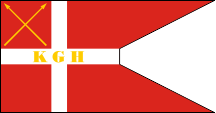
1795–1846,
Official flag of the Danish government in Greenland,
Source, by: Flags of the World



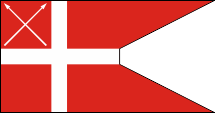
1846–1979,
Official flag of the Danish government in Greenland,
ratio – ratio = 28:53,5
Source, by: Die Welt im bunten Flaggenbild, Flags of the World



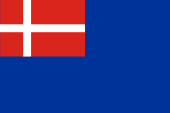
1798–1842,
Flag for Danish ships en route to the Danish West Indies,
Source, by: World Statesmen,
mgg.dk,
FOTW



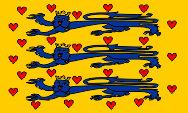
14th century,
Banner of the King,
Source, by: Wikipedia (DE)



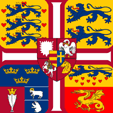
1863–1906,
Flag of the King (Christian IX.),
ratio = 1:1,



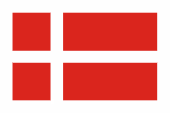
pilot (call) jack,
ratio = 2:3,
Source, by:
Die Welt im bunten Flaggenbild,
FOTW
This type of flag was abolished in the 20th century, today is:
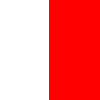 Pilot on board
Pilot on board
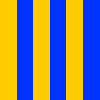 Call for Pilot
Call for Pilot




The Danish flag, called "Dannebrog", belongs to the oldest continuously used flags of the world. It shows a white cross on red background, which is moved to the pole side, the so-called Scandinavian cross, that will nowadays refer to the membership to the Nordic family of nations. To their origin, there exist many theories, but none of them can be confirmed as correct: Fact is, that the flag appeared first at the beginning of the 13th century for the first time, either during the 1219 Battle of Lyndanitz, which led the Danish King Valdemar II. against the Estonians, or in 1241 on the occasion of his funeral as his coffin was covered with the flag. One theory says, that the Danish flag goes back to the cross flag of the Holy Roman Empire of German Nation, which also showed a white cross on red ground, but it is unclear how and why the flag should have been transferred from Germany to Denmark. Maybe the Danes have brought the flag from a crusade with strong German contingents, where they fought under that flag. Another theory says, that the Order of St. John at that time was very active in Denmark, whose flag showed a white cross on red background too. The Order was preaching the idea of the crusade against the pagans in the Baltic region, and the Danes sailed under the flag of this Order in the fight. Thus, the flag could initially had appeared in 1219 at the Battle of Lyndanitz (Reval, Tallinn) against the Estonians. An other legend says, that the Danish King Valdemar II. spoted the image of the flag on the red heaven on 15th of June in 1219, during the Battle Lyndanitz, and have so helped the Danes to victory. A futher legend says that the flag had fallen during a critical point in the Battle of Lyndanitz from the sky into the hands of the Danish praying archbishop, and have so helped the Danes to victory. It is also possible that the Danish flag, like any other cross flags of this time have been awarded by the Pope, as the hallmark of the Crusaders.
The flag of Denmark showed only a few years after its first appearance the typical Scandinavian design with an extended arm of the cross, what could have been a fad, because the German Order used a flag with a Scandinavian cross too. But even in the 18th Century Danish flags were used with a central cross, often as a quadratic variation. At all times seems, that the Danish flag was in use in different variants, sometimes with the cross in scandinavian design, sometimes with the cross in the middle, sometimes as a rectangular flag. Between 1397 and 1523, the country was part of the Kalmar Union, a Danish-dominated union of the kingdoms of Denmark, Norway and Sweden that existed from 1397 to 1523. The Union was never formally fully consummated, but at times it was de facto effective, whenever a Danish king was actually king of all three countries. It was a political idea emanating from Denmark, which was supported outside Denmark only in parts of the nobility and the church. The flag of the Kalmar Union was a cross flag inspired by the Danish danebrog with a red cross on a yellow background. The Danish flag had been officially set for the first time in 1625 for the Danish Navy, as a swallowtail flag, than probably as rectangular flag in 1748 for merchant ships, and in 1854 as a state flag with a ccandinavian cross.
In the times in which the Order of St. John (Order of Malta) was still present as a maritime and trading power in the Mediterranean Sea (to 1798), and even until the middle of the 19th century, Danish merchant ships in the Mediterranean Sea had to complete their flag in the middle by a white box which carryed the initials of the Danish king in the middle, to avoid confusions with the flags of the Order.
The numerous Danish trading companies had the right to use the Danish flag, supplemented by their symbols and initials. The Danish East India Company worked between 1616 and 1650, and further between 1670 and 1729 under the name Ostindiskt Kompagni, and between 1770 and 1840 under the name Asiatisk Kompagni. There was also a Danish West India Company, between 1671 and 1680 under the name Vestindisk Kompagni, and further between 1680 and 1776 under the name Det Vestindisk-Guineiske Kompagni. The in 1897 foundet East Asian Company (Østasiatiske Kompagni) exists until today. From the flag of the in 1897 founded Royal Greenlandic Trading Company (Kongelige Grønlandske Handel) descents the later flag of the Danish administration for Greenland. It showed two crossed harpoons in the upper corner and was used until 1979.
Source: Flags of the World,
Wikipedia (D),
Flaggen und Wappen der Welt,
Wikipedia (D),
Wikipedia (D)

Æro
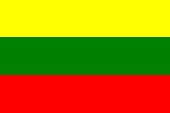
Insel Æro (also: Ærø, Aerø, Aerö),
Thanks to: Gunter Eisermann



Æro Island (34 sq.mi., 8.600 inh., main place: Marstal 4300 inh.) has since centenaries the right to use an own flag. The fag of Denmark is officially not in use here.

Bornholm
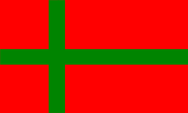
Bornholm Island, Variant 1:



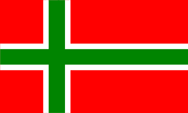
Bornholm Island, Variant 2:



Bornholm Island (227 sq.mi., 42 800 inh., main place: Rønne 16 000 inh.) has officially no own flag. The above shown variants are unofficial or fantasia flags.


Coat of arms of Denmark,
Source: Corel Draw 4,
Flaggen und Wappen
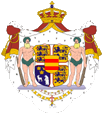
Coat of arms of the Queen of Denmark,
Source: Corel Draw 4,
Flaggen und Wappen

The Danish coat of arms shows three blue lions and nine red hearts on a golden shield. In this form it is known since King Waldemar I. (1157–1182). After the separation of Norway (1815) this coat of arms in 1819 was officially re-introduced as the national emblem. The arms of the king shows a by a white, red-framed cross quartered shield that shows in the first and fourth quadrants the Danish shield with three blue lions and red hearts. In the second quadrant is placed the coat of arms of Schleswig, two blue lions on gold, and in the third quadrant, it it shows on blue, the three crowns of the Kalmar Union (Denmark, Sweden, Norway), a sheep (Faroe Islands) and a polar bear (Greenland). In the middle of the shield is placed a heart-shield bearing the arms of the House of Schleswig-Holstein-Sonderburg-Glücksburg. Supporters are two "wild men" with clubs. The crest is highlighted with a purple and white coat, and above it a golden crown.
Source: Flaggen und Wappen der Welt

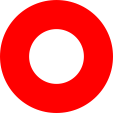
Aircraft Roundel,
Source, by: Wikipedia (EN)

Location:
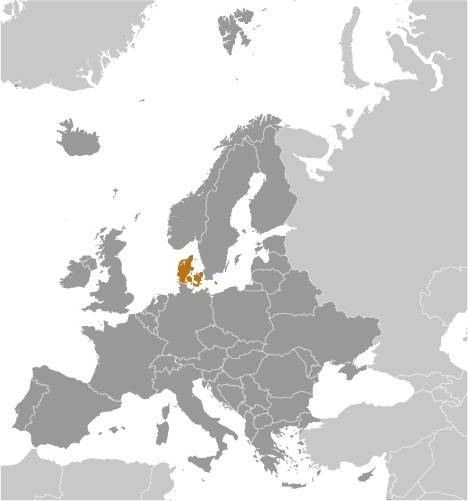
Source: CIA World Factbook
Map of the country:
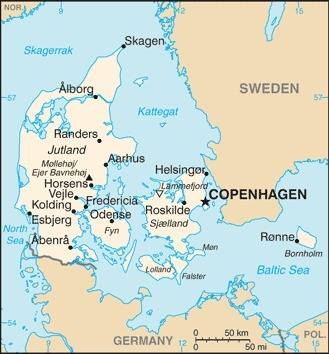
Source: CIA World Factbook

Area: 16.572 square miles (without Faroe Islands and Greenland)
Inhabitants: 5.822.800 (2020), davon 86.3% Dänen, 0,3% Deutsche (als nationale Minderheit)
Religions: 74,4% Protestant, 0,6% Roman Catholic, 5,3% Muslim
Density of Population: 351 inh./sq.mi.
Capital: København (Copenhagen), 632.340 inh. (2020)
official Language: Danish
andere Languages: Greenlandic, Faroese, German
Currency: 1 Danish Crown (dkr, DKK) = 100 Oere
Time Zone: GMT + 1 h
Source:
Wikipedia (D),
Wikipedia (NO)

6th century · immigration of the Danes, coming from Scania
899 · founding of the Danish kingdom
960 · the German Emperor Otto I. gives King Harald Bluetooth his country as fiefdom, the Danish Mark is founded => Denmark, beginning of the christianization
990–1035 · expansion of Denmark under King Svend Forkbeard, conquest of Norway, Schleswig and England
1016–1042 · personal union of the Kingdoms of Denmark and England
1035 · secession of Norway under a separate Danish dynasty (Ulfinger)
1155 · expansion of Denmark under King Valdemar I., the conquest of Estonia and parts of Pomerania
1227 · Battle of Bornhöved (in Holstein), Denmark loses nearly all possessions at the German Baltic coast, later Rügen Island and Northwestern Pomerania (1325)
1346 · Denmark sells Estonia to the Teutonic Order
1361 · Denmark conquers Gotland and plunders the Hanseatic City of Visby, followed by Hanseatic vendettas against Copenhagen
1370 · Peace of Stralsund, Denmark recognizes the supremacy of the Hanseatic League in the Baltic Sea
1387 · election of Margaret (daughter of the last Danish King, widow of the king of Norway) to the Queen of Denmark and Norway
1388 · election of Margaret to the Queen of Sweden
1397 · establish of the Kalmar Union, association of Denmark, Sweden and Norway under one crown
1523 · separation of Sweden from the Kalmar Union, with enduring clashes in the afteryears with Sweden
1536 · introduction of the reformation
1620 · Denmark acquires the town of Tranquebar at the east coast of India
1643 · Sweden declares war on Denmark
1657–1679 · Denmark operates several trading posts on the Gold Coast in Africa, today's Ghana (1657-1659 Fort Witzen, 1658-1685 Fort Royal, 1659-1661 Fort Cape Coast, 1659-1674 Fort William, 1659-1679 Fort Christiansborg)
1658 · Peace of Rosklide, Denmark has to cede the countries of Skåne, Halland, Blekinge and Bohuslän to Sweden, and thus the original home of the Danes
1672 · St. Thomas (Caribbean) becomes a Danish colony
1620 · Denmark acquires the town of Serampore in Bengal (India)
1684 · St. John (Caribbean) becomes a Danish colony after fights with England
1733 · the Danish West India Company buys St. Croix (Caribbean) from France
1784–1850 · Denmark operates several trading posts on the Gold Coast in Africa, today's Ghana (1784-1850 Fort Friedensborg, Fort Konigstein and Fort Prinzenstein, 1787-1850 Augustenborg)
1814 · End of the personal union with Norway, Norway becomes ceded to Sweden
1845 · Denmark sells Tranquebar and Serampore to Great Britain
1846–1869 · the Nicobar Islands (Bay of Bengal) are a Danish possession
1849 · introduction of constitutional monarchy
1864 · German-Danish War, Denmark has to cede Schleswig and Holstein
1914–1918 · First World War, Denmark is neutral
12th of December 1916 · Denmark sells the Virgin Islands (St. Thomas, St. John and St. Croix) to the USA
1918–1944 · Danish Iceland is connected as an independent kingdom in personal union with Denmark
1920 · after a referendum Germany must cede Northern Schleswig to Denmark
1939–1945 · Second World War, Denmark is neutral, but becomes occupied by German troops on 9th of April in 1940, 8000 Danes fight now as volunteers at the site of the German Empire, but emergence of a resistance movement too
23rd of December 1943 · Iceland terminates the personal union with Denmark
17th of June in 1944 · after a referendum Island becomes transformed into a republic
5th of May 1945 · the German occupation forces hand over Denmark to an allied administration
1945 · founding member of the UN
1946 · the allied troops leave Denmark
1949 · founding member of NATO
1953 · Greenland becomes a component with equal rights within the Kingdom of Denmark
1973 · joining to the EC (the later EU)
1979 · Denmark grants Greenland internal self government
2000 · rejection of joining the Euro-zone
Source:
Wikipedia (D),
Atlas zur Geschichte,
World Statesmen,
RetroBib Retrobibliothek

When in 960 the German Emperor Otto I. gives the Danish King Harald Bluetooth his country as a fiefdom, came in this way into being the "Danish Mark". A Mark is a border province. The word "marca" is an Old High German word and means "edge".
Source:
Handbuch der geographischen Namen,
Atlas der wahren Namen


![]()





































































































